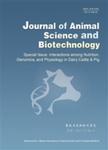Effects of dietary energy density on plasma glucose and lipid profile,morphological aspects and chemical characteristics of adipose tissue in finishing pigs
Effects of dietary energy density on plasma glucose and lipid profile,morphological aspects and chemical characteristics of adipose tissue in finishing pigs作者机构:HubeiKeyLaboratoryofAnimalNutritionandFeedScienceWuhanPolytechnicUniversityWuhanHubci430023China InstituteofSubtropicalAgriculturetheChineseAcademyofSciencesChangshaHunan410125China
出 版 物:《Journal of Animal Science and Biotechnology》 (畜牧与生物技术杂志(英文版))
年 卷 期:2010年第1卷第1期
页 面:25-34页
学科分类:082604[工学-军事化学与烟火技术] 0905[农学-畜牧学] 08[工学] 09[农学] 0826[工学-兵器科学与技术]
基 金:the National Basic Research Program of China (2004CB117504)for the financial support
主 题:adipocyte morphology adipose tissue energy density finishing pigs peroxisome proliferator-activated receptor-~/
摘 要:ABSTRACT: Peroxisome proliferator-activated re- ceptor-Υ (PPAR-T) plays a pivotal role in controlling adipogenesis. We hypothesized that changes in dietary energy density might alter fat deposition in finishing pigs via modulation of the expression of PPAR-Υ . To test this hypothesis, thirty female finishing pigs were fed diets containing low ( LD ), medium ( MD ) or high (HD) energy density. Blood samples were col- lected on day 53, and then the pigs were sacrificed to collect samples of the dorsal subcutaneous ( ST), ab- dominal (AT) and mesenteric (MT) adipose tissue. Compared with pigs fed the MD diet, malate dehydro- genase activity was increased in the ST and MT of pigs fed the HD diet, while activity was decreased in the MT of pigs fed the LD diet (P 〈 0.05). Glucose- 6-phosphate dehydrogenase activity was increased in all three fat depots of pigs fed the HD diet (P 〈0.05) in comparison with pigs fed the MD diet. Both HD and LD diets increased the size of the adipocytes in the AT and MT ( P 〈 0.05 ). Pigs fed the HI) diet had a higher cell proliferation index in the ST com- pared with pigs fed the other two diets (P 〈 0.05 ). Compared with pigs fed the MD diet, a decreased ap- optosis index was seen in the ST of pigs fed the HD diet, and in the AT of pigs fed the LD diet, as well as in the MT of both HD and LD fed pigs ( P 〈 0.05). PPAR-Υ positive percentage was elevated in the ST and MT of HD fed pigs compared with pigs fed the MD and LD diets, while it was decreased in the ST of LD compared with MD fed pigs ( P 〈 0.05 ). These results suggest that dietary energy density may regu- late fat deposition in fmishing pigs. It is possible that feeding a high energy diet may induce fat deposition via up-regulation of PPAR-Υ expression.



